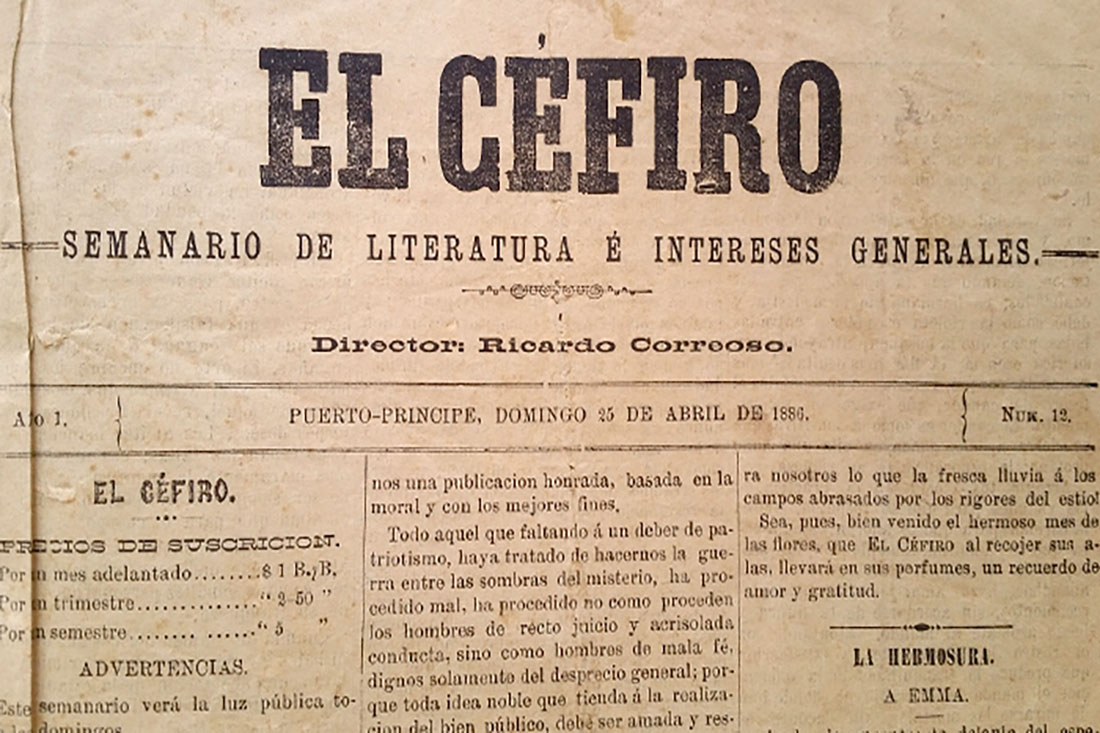The history of the Camagüey press saw the birth towards the last months of 1866 of its first literary newspaper, El Céfiro. This publication has a particularity: its director Domitila García de Coronado, upon founding it, became the first female to create a periodical publication in Cuba. The life of this unique woman would be marked by literature from her first steps.
Domitila was born in Santa María del Puerto del Príncipe on May 7th, 1847. In 1859 she moved with her family to Manzanillo, where her father, Rafael García, a journalist and printer with progressive ideas, bought a modest printing press where he published La Antorcha newspaper. Among the main editors of this publication were the notorious independence patriots Carlos Manuel de Céspedes, and the prestigious essayist, journalist, diplomat and cultural entertainer Rafael María Merchán.
This young woman assumes the entire inheritance of her father in the form of letters, ink and support for the independence struggle. From the early age of 13 she began to write her first press releases, although she was more adept at typesetting, acquiring surprising speed. Her outstanding work in that task led to her being assigned the responsibility of assembling the letters that formed the first proclamations in which Céspedes urged Cubans to free themselves from the Spanish colonial yoke. In the first months of 1865, Domitila’s father moved his newspaper to Puerto Príncipe where it was released for about a year.
The return
From this city, on November 29th, 1866, Domitila founded El Céfiro magazine, on a weekly basis, a company in which she had the support of the new poets from Camagüey Sofía Estévez y Valdés and Emilio Peyrellade. The magazine had a literary and traditional style, where poetry, some reviews of cultural shows were perfectly combined with events on the social life of the city.
El Céfiro also became a space where her main editor expressed her political concerns; this was fostered by her relationship with the nationalist ideas of Agramonte and with the patriot himself during his stay in the city. The consistency of her work, thanks to her excellent grammatical and technical training, consolidated in her functions as a typographer, made it possible for El Céfiro to transcend the entire country as a varied and serious review of the cultural, historical and social events of the town and also the rest of the insula. However, it was only published until November 1868. Already at that time the Revolution led by Céspedes shocked the entire nation.
Legacy
Domitila, despite not being able to continue working at El Céfiro, continues her work as a journalist, writer and revolutionary. She was 21 years old when she was commissioned to write, at her father’s printing house, the Manifesto of the Revolutionary Junta of the Island of Cuba, written by Céspedes. Shortly after, she published her novel Los enemigos íntimos.
Based in the capital, she collaborated, along with Enrique José Varona and Juana Borrero, among other renowned intellectuals, in the scientific, artistic, literary, fashion, news and advertisements newspaper, El Eco de las Damas. Domitila, in the same way, wrote for the magazine El Eco de Cuba, of science, philosophy and letters, which had been founded on September 15th, 1886 under the direction of José María Céspedes and the doctor and journalist Tiburcio Castañeda.
In 1870 the young revolutionary printed, at the risk of her life, the independence newspaper Laborante, which was promptly banned by the Spanish colonial government. A decade later, in an effort to unleash her vocation as a pedagogue, in 1882 she founded the Nuestra Señora de los Ángeles private school in Havana, aimed at poor and orphaned children.
Camagüey city should be grateful, without a doubt, for a publication like El Céfiro, which portrayed its everyday life and displayed its rich culture. In addition, which once again placed us in the history of Cuban literature by the hand of Domitila García de Coronado, renowned writer, editor and educator.
Translated by: Aileen Álvarez García






